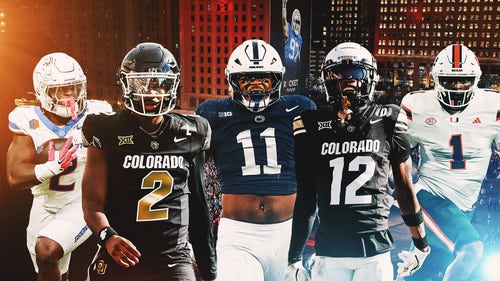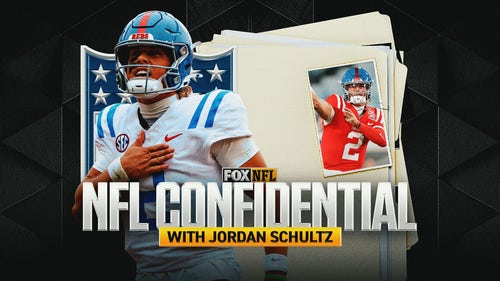
Skill matters more than WRs' size, speed
The NFL continues to pick on the little guy.
In fact, I’ll take it even further.
Personnel evaluators continue to discriminate against the slower wide receivers — big or small.
I find it interesting that two of the NFL’s best young receivers, Steve Johnson and Marques Colston, were selected in the seventh round because they didn’t have the ideal speed personnel evaluators were looking for, and they’ve been unfairly called possession receivers.
Yet Colston, in his five seasons with the New Orleans Saints, has posted 1,000 yards receiving four times. And he probably would have posted another 1,000-yard season had he not missed five games during the 2008 season because of injury. And Johnson (6-foot-2), who has good size like Colston (6-4), is coming off of a huge season for the Buffalo Bills: 82 receptions for 1,073 yards and 10 touchdowns.
Sure, it helps that Colston has Drew Brees throwing to him, but the fact is that he has been incredibly productive despite his supposed less-than-ideal speed.
The debate has been going on for years: How much does speed really matter at wide receiver?
Speed WRs vs. possession WRs
The discrimination toward taller or shorter wide receivers who don’t run fast isn’t limited to just Colston and Johnson.
Wes Welker, arguably the NFL’s best slot receiver and perhaps one of the best in NFL history, was signed by the San Diego Chargers as an undrafted free agent in 2004. They didn’t think enough of him to keep him around for very long and waived him just after the start of the regular season. The Miami Dolphins, who signed him a week later, were willing to trade him in 2006 to the New England Patriots in exchange for second- and seventh-round picks. That’s quite a bit to give up for a guy who supposedly doesn’t run very well, right?
But keep in mind player evaluation is about more than just statistics. It’s about how you project that a player can fit into your offensive or defensive system.
Patriots head coach Bill Belichick, who pulled the trigger on the deal, is usually the one who is dealing away players or draft picks for more selections. The fact that he was willing to give up two draft picks for a player who really hadn’t come into his own yet is saying something.
What Welker has done since joining the Patriots is nothing short of amazing.
He’s No. 1 in receptions (432) during the past four seasons and is also No. 1 in receptions per game (7.1). Welker tied an NFL record in 2009 with seven 10-plus reception games. And during the 2008 season, when he posted 112 receptions, he finished second in yards after the catch (6.6), which speaks to his toughness. And he tied Calvin Johnson for passes targeted with 150. He also caught 75 percent of the passes thrown to him that season to lead the NFL.
The Patriots clearly believe that a 10- or 11-yard completion (Welker’s per catch average for his career is 10.7) is just as good as a run for that distance. And Welker’s ability to get open in confined space, according to personnel sources, is probably the best in the NFL.
I would be willing to bet that Welker’s 10-yard speed is probably near the top of all wide receivers. Short-area quickness has to be one of the most underrated traits for a receiver to have in the NFL.
Is it really all about long speed?
Speed receivers such as Lee Evans and Donte’ Stallworth are easier to defend because they tend to only do one thing — run deep. But don’t blame them: Blame the play designer.
“Early in the year, it was the same as I watched on film the year before, people doubling Lee to take him out of the game. People saw the threat and they were going to make sure Lee didn’t beat them,” Bills coach Chan Gailey said during the NFL head coaches breakfast at last week’s NFL owners meetings. “As the year went on, that started to balance up and not swing his way after about midseason. He had a couple of games that were good. But I’m hoping that we can really get Lee consistent running routes and consistent at doing a lot of things. He’s been more of a deep threat. I’ve got to get him to do a better job of becoming an underneath threat. I’ve got to do a better job of that.”
And if it’s all about speed, then why didn’t former first-round pick Troy Williamson make it? Williamson, who ran a blistering 4.32 in the 40-yard dash during the 2005 NFL Scouting Combine, struggled with dropped passes. Other speed receivers in recent drafts such as Darrius Heyward-Bey and Ted Ginn are still struggling to make an impact.
Hands and route running are also important
Just because a wide receiver can run fast, that doesn’t really indicate future success.
While NFL scouts will often say speed is likely the first trait that they look for when evaluating the position, few receivers are as fast as the personnel evaluators would like.
Hands, route running and toughness are the traits that are just as important. If a wide receiver can’t hold onto the ball, drops passes or isn’t willing to run over the middle on occasion, how dependable could he really be?
That’s why players such as Welker, Davone Bess, Steve Smith (New York Giants), Austin Collie, Lance Moore, Hines Ward and Danny Amendola — yes, him, too — are very important for a quarterback. You can almost call them a second tight end; they’re just not as big. And those players will move the chains for many first downs.
This year’s NFL draft has plenty of solid receivers who will play in the league a long time but might not light up a stopwatch with a fast 40-yard dash time.
Vincent Brown (San Diego State), Jeremy Kerley (TCU), Greg Salas (Hawaii), Ryan Whalen (Stanford), Dane Sanzenbacher (Ohio State) are examples of players who won’t blow anyone away with their speed, but they do everything well — catch the ball, run over the middle and run good routes.
The bottom line is that size and speed really don't matter as much you think at wide receiver — it’s all about production and projecting how that player fits in with a particular offensive scheme.










